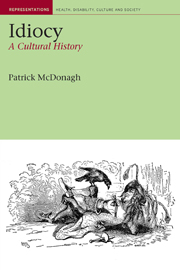Book contents
- Frontmatter
- Contents
- Preface and acknowledgements
- 1 Introduction: idiocy, culture and human relations
- 2 ‘Stripping our own hearts naked’: William Wordsworth and John Wilson read ‘The Idiot Boy’
- 3 A ‘pupil of innocent Nature!’ The wild boy of Aveyron goes to Paris
- 4 Diminished men: masculinity and idiocy
- 5 Essential women: femininity and idiocy
- 6 Holy fools, witty fools, depraved fools: folly, innocence and sin
- 7 History, society, economy: holy fools and idiots come home in nineteenth-century literature
- 8 Barnaby Rudge, idiocy and paternalism: assisting the ‘poor idiot’
- 9 Innocence, philanthropy and economics: the new ‘asylum’ idiot
- 10 Sensational idiocy
- 11 ‘The sins of the fathers’: idiocy, evolution and degeneration
- 12 Danger and degeneracy: the threat of the urban idiot
- 13 The problem of the feeble-minded: the Royal Commission, eugenics and eternal chaos
- Epilogue
- Bibliography
- Index
7 - History, society, economy: holy fools and idiots come home in nineteenth-century literature
- Frontmatter
- Contents
- Preface and acknowledgements
- 1 Introduction: idiocy, culture and human relations
- 2 ‘Stripping our own hearts naked’: William Wordsworth and John Wilson read ‘The Idiot Boy’
- 3 A ‘pupil of innocent Nature!’ The wild boy of Aveyron goes to Paris
- 4 Diminished men: masculinity and idiocy
- 5 Essential women: femininity and idiocy
- 6 Holy fools, witty fools, depraved fools: folly, innocence and sin
- 7 History, society, economy: holy fools and idiots come home in nineteenth-century literature
- 8 Barnaby Rudge, idiocy and paternalism: assisting the ‘poor idiot’
- 9 Innocence, philanthropy and economics: the new ‘asylum’ idiot
- 10 Sensational idiocy
- 11 ‘The sins of the fathers’: idiocy, evolution and degeneration
- 12 Danger and degeneracy: the threat of the urban idiot
- 13 The problem of the feeble-minded: the Royal Commission, eugenics and eternal chaos
- Epilogue
- Bibliography
- Index
Summary
The natural fool – the innocent, the trickster, the depraved – is a vibrant, complex actor in medieval and early modern society, and so it should come as no surprise that nineteenth-century writers, looking back at the store of characters and images bequeathed to them by literary and cultural history, should also light upon the fool as a means of ironic commentary and social critique. But, of course, when the social context shifts, so too do the fool's specific functions. By the nineteenth century, the ‘natural’ fool is an anachronism, and the individuals so designated have been replaced in the public consciousness by the more formal ‘idiot’. Thus, while the associations of natural and holy folly are continuous, there are significant changes in the way authors sought to give their ‘fool’ characters a form that was not only accessible but also meaningful to nineteenth-century readers.
Thus, Walter Scott could use his ‘fool’ character David Gellatley to comment on political intrigues and developments in Waverley (1814), as well as to mark a certain strain of ‘Scottishness’. Charles Dickens could use his fool characters, and the pervasive theme of idiocy, to present a critique of moral responsibilities, both individual and social, in Little Dorrit (1857). And George Eliot could use Jacob, in Brother Jacob (1860), as a tool for helping to carry out an analysis that blends the moral with the economic.
- Type
- Chapter
- Information
- IdiocyA Cultural History, pp. 152 - 169Publisher: Liverpool University PressPrint publication year: 2008



